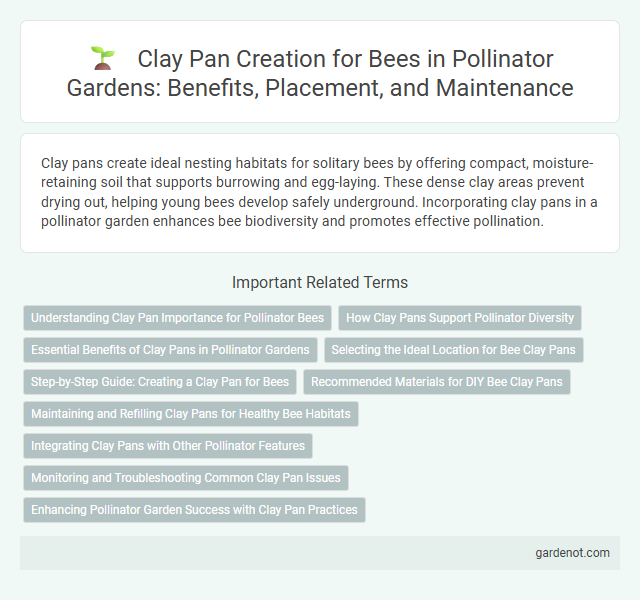Clay pans create ideal nesting habitats for solitary bees by offering compact, moisture-retaining soil that supports burrowing and egg-laying. These dense clay areas prevent drying out, helping young bees develop safely underground. Incorporating clay pans in a pollinator garden enhances bee biodiversity and promotes effective pollination.
Understanding Clay Pan Importance for Pollinator Bees
Clay pan soils provide essential nesting materials for ground-nesting bees, offering a compact yet workable texture that supports the construction of stable burrows. These dense clay layers retain moisture, facilitating ideal conditions for egg incubation and larval development within bee nests. Understanding the role of clay pans helps enhance pollinator garden design, promoting healthy bee populations and improving pollination efficiency.
How Clay Pans Support Pollinator Diversity
Clay pans provide essential nesting habitats for solitary bees by offering compact, moisture-retentive soil ideal for excavating brood cells. These specialized microhabitats support pollinator diversity by enabling ground-nesting bees like mining bees (Andrena spp.) and plasterer bees (Colletes spp.) to reproduce successfully. Enhancing clay pan areas within pollinator gardens promotes a wider range of native bee species, contributing to ecosystem resilience and effective pollination.
Essential Benefits of Clay Pans in Pollinator Gardens
Clay pans provide vital nesting habitats for ground-nesting bees, enhancing biodiversity in pollinator gardens. Their compact texture allows bees to burrow and lay eggs safely, promoting robust pollinator populations. Incorporating clay pans supports natural pollination processes essential for healthy ecosystems and increased plant reproduction.
Selecting the Ideal Location for Bee Clay Pans
Selecting the ideal location for bee clay pans involves choosing a spot that offers shelter from heavy winds and direct afternoon sun to maintain optimal moisture levels for nest building. Position clay pans near diverse flowering plants, especially native species, to provide easy access to pollen and nectar, ensuring robust pollinator activity. Soil composition and drainage are critical; well-drained areas with clay-rich soil prevent waterlogging, creating a favorable habitat for ground-nesting bees.
Step-by-Step Guide: Creating a Clay Pan for Bees
Creating a clay pan for bees involves selecting natural, untreated clay and mixing it with sand to improve drainage and texture. Shape the mixture into shallow pans or trays with varied depths, embedding them in a sunny, sheltered spot within your pollinator garden. Regularly moisten the clay pans to maintain the ideal nesting environment for ground-nesting bees seeking mud to build brood cells.
Recommended Materials for DIY Bee Clay Pans
Recommended materials for DIY bee clay pans include natural clay mixed with sand to ensure proper texture and durability, allowing bees to easily mold and access nesting sites. Incorporating organic matter such as finely shredded leaves or compost can enhance moisture retention and create a favorable environment for solitary bees. Using untreated, non-toxic components avoids harmful chemicals, promoting a safe habitat for native pollinators.
Maintaining and Refilling Clay Pans for Healthy Bee Habitats
Maintaining and refilling clay pans in pollinator gardens ensures a vital source of nesting material for native bees, especially mason and clay-loving species. Regularly replenishing the clay with moist, fine-grained soil supports healthy bee populations by providing optimal conditions for creating brood cells and protecting larvae. Proper upkeep of these clay pans enhances biodiversity and strengthens pollination services in the garden ecosystem.
Integrating Clay Pans with Other Pollinator Features
Integrating clay pans with diverse pollinator features enhances habitat suitability by providing bees with essential nesting and mud-gathering sites alongside abundant forage. Positioning clay pans near native flowering plants, water sources, and bee hotels creates a multifunctional environment that supports a wider range of pollinator species and life stages. Strategic placement within pollinator gardens maximizes resource availability, promoting healthier, more resilient pollinator populations.
Monitoring and Troubleshooting Common Clay Pan Issues
Monitoring clay pans in pollinator gardens involves regularly checking moisture levels and soil texture to prevent cracking or compaction that can hinder bee nesting. Common issues include waterlogging and excessive dryness, both of which disrupt the ideal conditions for clay pan bees. Implementing proper drainage solutions and maintaining balanced soil moisture ensures a healthy habitat that supports pollinator activity and nesting success.
Enhancing Pollinator Garden Success with Clay Pan Practices
Clay pans provide essential nesting habitats for ground-nesting bees, promoting biodiversity in pollinator gardens. Incorporating clay-rich soil patches encourages solitary bee species, key pollinators for many crops and native plants. Managing moisture and compaction in these clay pans optimizes nesting conditions, enhancing pollination efficiency and garden productivity.
Clay pan (for bees) Infographic

 gardenot.com
gardenot.com